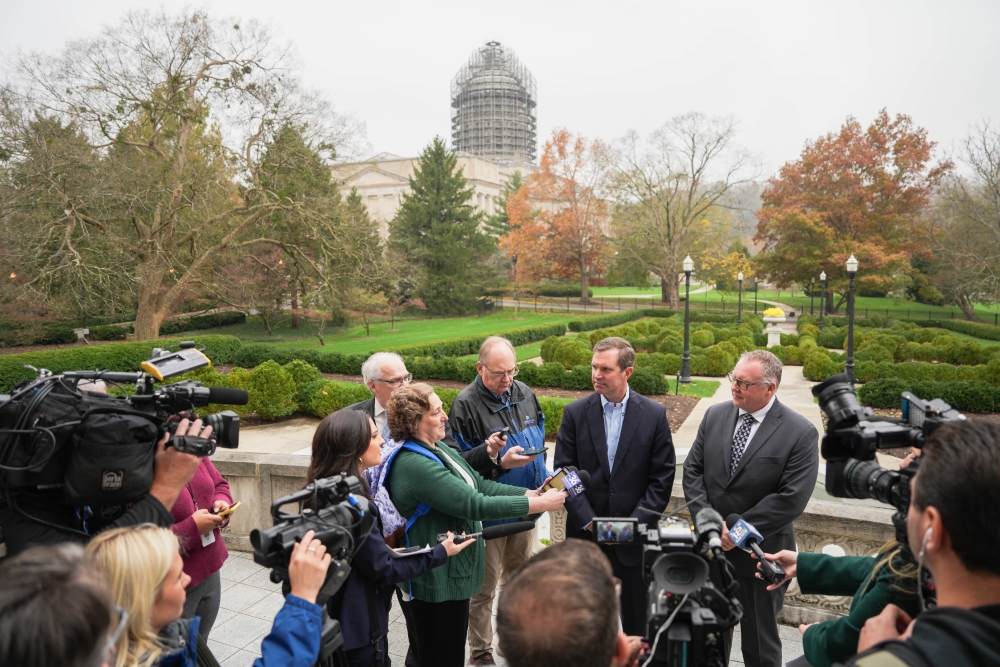Setting records for economic achievement has become a habit in Kentucky.
Since Gov. Andy Beshear took office on December 10, 2019, Kentucky has shattered record after record for economic development in state history.
Since Gov. Andy Beshear took office on December 10, 2019, Kentucky has shattered record after record for economic development in state history.
Quantifying the impact of Kentucky’s economic turnaround is an exercise in crunching eye-opening numbers. Whether measured by jobs, capital investment or number of corporate facility projects, the Bluegrass State has achieved unprecedented levels of success under the Beshear Administration.
Consider the Tale of the Tape:
- More than 1,100 private-sector new and expanded location projects have been announced in Kentucky during his tenure.
- Capital investment into these deals has exceeded $35 billion.
- More than 60,000 new jobs have been created by these projects.
Not only is this the highest investment figure of any governor to serve Kentucky; it is $14 billion more than the next highest total.
The new jobs pay better too. Since 2022, the average incentivized hourly wage in Kentucky has topped $26 in three straight years for the first time in state history.
The jobs announcements often have come with transformative projects. Among them are the $5.8 billion, 5,000-job BlueOval SK Battery Park investment by Ford Motor Company and SK On in Hardin County; Toyota’s $1.3 billion investment in Scott County; Shelbyville Battery Manufacturing’s $712 million investment in Shelby County; and Ascend Elements’ nearly $1 billion investment in Christian County.
Site selectors are taking notice. During this record-setting run, Site Selection Magazine has recognized Kentucky as one of the top states for economic development performance in attracting corporate facility investment projects. Just last March, Site Selection ranked Kentucky No. 3 in the nation and No. 1 in the South-Central Region for total projects per capita in the magazine’s annual Governor’s Cup rankings. Last April, Site Selection ranked Kentucky No. 2 in the South-Central Region and in the top 10 nationally in the publication’s annual Prosperity Cup rankings, which recognize state-level economic development agencies for their success in winning capital investment projects.
The primary beneficiaries of these achievements are the people of Kentucky. Last year, Kentucky established a new record by tallying the longest period with the lowest unemployment rates in state history. Kentucky also secured the largest General Fund surplus and Rainy-Day Fund, giving taxpayers the assurance of a huge nest egg in Frankfort. Kentucky received rating increases from America’s major credit rating agencies Fitch Ratings, S&P Global Ratings and Moody’s Investors Service.
On top of that, Kentucky established a new benchmark in exports during 2024 and marked the state’s most successful two years in tourism.

Gov. Andy Beshear has made increasing foreign direct investment one of his administration’s top priorities. Here, he celebrates yet another big FDI win for the state.
Photo courtesy of the Office of the Governor
Factors Driving Growth
Kristina Slattery, commissioner for the Department of Business & Community Development for the Kentucky Cabinet for Economic Development, said that the record-breaking success “came from focusing on our core industries. We continue to let industry drive what the needs are for projects.” She then cited the following factors driving growth:
- “Keeping relationships strong with core industries.”
- “Tracking new trends, challenges and opportunities in key markets.”
- “Leaning into our advantages such as logistics.”
- “Delivering a high level of service to companies.”
- “Encouraging industry to help drive change.”
“We punch outside of our weight class,” Slattery said. “We have been smart about supply chain development,, and we listen to our companies.”
This strategy has enabled Kentucky to land projects such as Shelbyville Battery Manufacturing, the largest job creation project in Kentucky since 2022. Announced this past November, this project will create nearly 1,600 high-tech jobs. Gov. Beshear, in announcing the deal, said, “This is the single largest investment and job creation announcement we have on record for Shelby County, and it is the largest project Kentucky has seen this year. This project will solidify our role as a leader in the country’s energy storage sector and will transform our economy, creating opportunities for Kentucky’s families for generations.”
Kentucky is not content to stop there. Rather, the Bluegrass State plans to build on this momentum by ushering in even more programs to help industry grow. For example, Gov. Beshear previously announced a Supply Kentucky initiative that will reduce costs and provide more security in the supply chains of Kentucky companies. He followed that up by announcing New Kentucky Home, a broad-based plan to increase economic investment, attain and attract talent, and increase tourism across the state.
Why Leadership Matters
Jeff Noel, secretary of the Kentucky Cabinet for Economic Development, said the governor’s strong leadership is the biggest factor behind the state’s long run of success.
“I am a firm believer that everything begins with leadership,” Noel said. “The governor has great charisma. He takes seriously the commitment of Kentucky to these companies. We go through every project and everything that needs to be done for each project. He demands that we stay on top of things. That leadership from the governor and the process we use — that is the reason Kentucky is winning.”
Noel cites changes like new investments into technical training, Build-Ready Sites, road construction, and improving speed to market as critical factors in perpetuating this Kentucky turnaround.
“If you are going to be successful in economic development, you have to realize that all of these things are interdependent,” Noel added. “In a world changing so fast, sometimes you have to step back and understand that you can’t be successful with just a series of emails and conference calls. It takes personal relationships. The personal involvement of the governor is key. That is the hallmark of why Kentucky is successful.”
Talent Migrating to Kentucky
According to a recent demographic analysis, Kentucky is already showing gains in attracting the kind of talent that companies crave. Hamilton Lombard, demographic researcher at the Weldon Cooper Center for Public Service at the University of Virginia, analyzed the migration patterns of 25-to-44-year-olds around the country and found that Kentucky is a leader in attracting them.
“Kentucky has seen a similar pattern as many Midwest states with migration trends reversing in recent years,” he said. “Most years during the 2010s, Kentucky had more people leave it for other states than move to it; but every year since 2020, the commonwealth has attracted more new residents from other states than it has lost. A disproportionate share of Kentuckians who left were younger adults, causing its population age 25 to 44 to shrink during much of the 2010s. During the early 2010s, Kentucky lost the seventh largest number of young adults among U.S. states. But between 2020 and 2023, Kentucky’s age 25 to 44 population has grown by close to 11,000, a larger number than in Minnesota or Massachusetts.”
Lombard also found out where these younger adults are moving. By and large, he said, they are moving to counties heavily focused on manufacturing.

“We punch outside of our weight class. We have been smart about supply chain development, and we listen to our companies.”
— Kristina Slattery, Commissioner of Business & Community Development, Kentucky Cabinet for Economic Development
“The resurgence in domestic manufacturing has helped reverse migration trends in most manufacturing-dependent counties,” he said. “In 2020, for the first time since the mid-2000s, more Americans moved to manufacturing-dependent counties than left them. This trend has continued each year since 2020, helping boost population growth in much of Kentucky.”
This bodes well for Kentucky’s economic future, particularly as the state commits to an economic strategy aimed at growing advanced manufacturing sectors.

